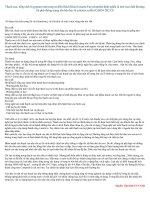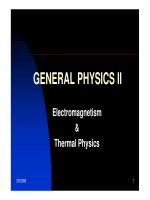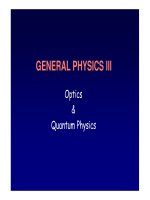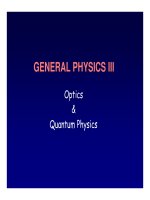Tài liệu Chapter 12: EDTA Titrations docx
Bạn đang xem bản rút gọn của tài liệu. Xem và tải ngay bản đầy đủ của tài liệu tại đây (1.09 MB, 49 trang )
Chapter 12:
EDTA Titrations
Review of Textbook for Chem115/116: Chapters
17 & 23: Complex (coordinate compound)
Coordinate covalent bonds: a bond formed when
both electrons of the bond are donated by one atom.
Ag
+
+ 2(:NH
3
) [H
3
N: Ag :NH
3
]
+
Electron configuration of Ag [Kr]4d
10
5s
1
5P
0
Ag
+
[Kr]4d
10
5s
0
5P
0
Sp hybrid orbitals: accommodate 2 pairs of electrons. Linear
Complex ion: A metal ion with Lewis base attached to
it through coordinate covalent bond.
Complex (Coordinate compound): a compound
consisting either of complex ions and other ions of
opposite charge or of neutral complex species.
I. Basic Concepts and Terms
A. Complex-Formation Reactions:
some elements (mostly metal ions) can form coordination
compounds with molecules/ions which have a "spare pair" of
electrons.
The central atom, (usually) a metal cation, accepts the pair of
electrons from the "donor molecule or ion" to form a coordinate
covalent bond.
The empty orbitals of the cation and the orbital occupied by the
bonding pair of electrons on the donor ion or molecule (ligand)
form a new molecular orbital.
The number of coordinate covalent bonds that a cation tends to
form with individual ligands (or functional groups on ligands) is
known as its coordination
number.
Typical values for coordination numbers are 2, 4 and 6.
The compounds formed can be neutral, positively or negatively
charged depending on the charge of the reacting species.
Example 12-1
Co
3+
+ 6 NH
3
<==> Co(NH
3
)
6
3+
Central atom= Co
3+
Ligand= :NH
3
Coordination number = 6
When a ligand has a single complexing or donor group in its structure, it
is said to be unidentate
,
when there are two groups, it is bidentate
,
When there are three groups, it is tridentate
ligand, etc.
When a bidentate (or higher number of donor groups present in the
ligand) forms a coordinate covalent compound with a metal cation, we
call the resulting compound a metal chelate
.
As titrants, multidentate ligands, particularly those w ith 4 to 6 donor
groups have the advantage that they usually react in a single step
pro c e s s , and the ir re ac tio ns w ith the me tal c atio n are more c o mple te
than their unidentate counterparts.
Y
4-
+ Co
3+
<=> CoY
-
cobalt(III)-EDTA complex
Example 12-2
Unidentate Ligand, :NH
3,
:I
[Co(NH
3
)
6
]
2+
, [CuI
2
]
-
Bidentate Ligand, glycine
HOOC-CH
2
CH
2
COOH
\ /
:N-CH
2
-CH
2
-N:
/ \
HOOC-CH
2
CH
2
COOH
Hexadentate Ligand: EDTA=Y [CoY]
-
Structure of a Metal/EDTA Chelate
Hexadentate
Octahedron
M
n+
+ Y
4-
<=> MY
(n-4)+
Complex of Metal/EDTA Titration Curves
Any Questions?
T
he EDTA has six sites, which can bind a metal cation:
the 4 carboxyl groups on the acetate groups and the
two amino groups on the ethylene group.
EDTA is a hexadentate
ligand and can coordinate up to
six positions on the central metal atom. The structure
of a compound with six coordination sites is octahedral.
HOOC-CH
2
CH
2
COOH
\ /
:N-CH
2
-CH
2
-N:
/ \
HOOC-CH
2
CH
2
COOH
II. Titrations with Ethylenediaminetetraacetic Acid (EDTA)
EDTA Disassociation
EDTA Dissociation Constants:
H
4
Y + H
2
0<=> H
3
Y
-
+ H
3
0
+
K
a1
= 1.02x10
-2
H
3
Y
-
+H
2
0<=> H
2
Y
2-
+ H
3
0
+
K
a2
= 2.14x10
-3
H
2
Y
2-
+H
2
0<=> HY
3-
+ H
3
0
+
K
a3
= 6.92x10
-7
HY
3-
+H
2
0<=> Y
4-
+ H
3
0
+
K
a4
= 5.50x10
-11
For our purposes, only the completely dissociated
EDTA ion w ill be
able to form a chelate with the metal ion. Therefore, the number
metal ions per unit volume solution chelated by EDTA w ill be pH-
dependent.
4321321
2
21
3
1
4
4321
T
-4
4
KKKK]H[KKK]H[KK]H[K]H[
KKKK
C
Y
α
++++
==
++++
Therefore, only EDTA solutions with pH's above 10 will [Y
4-
] as
a major fraction.
In addition, EDTA always forms 1:1 molar complexes
with metal
ions
n+
+ Y
-4
<=>
MY
(n-4)
T
n
4)-(n
4MYMY
4T
n
4)-(n
4n
4)-(n
MY
]CM[
]MY[
αKK'
α]CM[
]MY[
]][YM[
]MY[
K
+
+
+
+
−+
+
==
==
where K
MY
is the formation constant and K’
MY
is the conditional
formation constant.
4T
-4
4321321
2
21
3
1
4
4321
T
-4
4
αC][Y
KKKK]H[KKK]H[KK]H[K]H[
KKKK
C
][Y
α
=
++++
==
++++
III. Equilibrium Calculations Involving EDTA
A. Titration Curve: M
n+
+ Y
4-
<=> MY
(n - 4)+
A titration curve for the reaction of a cation with EDTA:
a plot of pM = (- log[M
n+
]) on the y-axis, versus volume (mL) of titrant
(EDTA solution) on the x-axis.
Note in Table 14-1, that the K
MY
values are in the range of 10
7
to 10
25
.
These reactions proceed very far to the right!
Since the fraction of [Y
4-
] is dependent upon pH, it is necessary to take
the pH of the solution into account when determining pM from the
equilibrium constant expression.
We can determine the fraction of EDTA
-4
, α
4
, as a function of pH (see
Table 14-2).
at pH = 10, α
4
= 0.35; the mole percent of [Y
4-
] is 35%
at pH = 11, α
4
= 0.85; the mole percent of [Y
4-
] is 85%
at pH = 12, α
4
= 0.98; the mole percent of [Y
4-
] is 98%
M
n+
+ Y
4-
<=> MY
(n-4)+
Complex of Metal/EDTA Titration Curves
Example 12-3:
Calculate the equilibrium concentration of Cu
2
+
in a solution with an
analytical CuY
2-
concentration of 0.0150 M at (a) pH 4.0 and (b) pH 10.
Cu
2+
+ Y
4-
<=> CuY
2-
K
CuY
2-
= 6.3x10
18
4T
2
2
42
2
CuY
αC ]Cu[
]CuY[
]][YCu[
]CuY[
K
-2
+
−
−+
−
==
T
2
2
4
CuY
'
C ]Cu[
]CuY[
αKK
-2-2
CuY
+
−
==
K’ is called as a conditional constant, which depends on pH.
]CuY[ ]Cu[C
22
Cu
2
−+
+=
+
Because K is very large (6.3x10
18
), [Cu
2+
] << [CuY
2-
]
Hence:
M0150.0]CuY[]CuY[ ]Cu[C
222
CuY
2
=≈+=
−−+
−
Eq.[1]
α6.3x10
0.0150
αK
]CuY[
K
]CuY[
]Cu[
4
18
4
CuY
2
''
2
2
-2-2
CuY
===
−−
+
(a) pH 4.0: α
4
= 3.6 X 10
-9
[Cu
2+
] = 8.1 X 10
-7
M
(b) pH 10.0: α
4
= 0.35 [Cu
2+
] = 8.2 X 10
-11
M
Example 12-4: Calculate the pCu
2
+
in a solution prepared by mixing
50.00 mL of 0.0300 M Cu
+2
with 50.0 mL of 0.0500 M EDTA at (a) pH
4.0 and (b) pH 10
.
Cu
2+
+ Y
4-
<=> CuY
2-
K
CuY
2-
= 6.3x10
18
4T
2
2
42
2
CuY
αC ]Cu[
]CuY[
]][YCu[
]CuY[
K
-2
+
−
−+
−
==
T
2
2
4
CuY
'
C ]Cu[
]CuY[
αKK
-2-2
CuY
+
−
==
M0150.0
L 0.100
M Lx0.030005000.0
]CuY[]Cu[C
2-2
Cu
2
==+=
+
+
Note:
[Cu
2+
]<< [CuY
2-
] (Why?)
Because K is very large (6.3x10
18
)
Hence: [CuY
2-
] =
C
Cu2+
=
1.50 X 10
-2
M
[Y
4-
]= α
4
C
T
C
T
= excess of EDTA + dissociation from CuY
2-
= 0.0100 M + [Cu
2+
]
[Cu
+2
] << excess of EDTA
M0100.0
L 0.100
)10x50.110x50.2(
EDTA of excessC
33
T
=
−
=≈
−−
T
2
2
4
CuY
'
C ]Cu[
]CuY[
αKK
-2-2
CuY
+
−
==
]Eq.1[
0.0100x α x 6.3x10
0150.0
CαK
0150.0
CK
]CuY[
]Cu[
4
18
T4
CuY
T
'
2
2
-2-2
CuY
===
−
+
(a) At pH = 4.0: α
4
= 3.6 X 10
-9
[Cu
+2
] = 6.6 X 10
-11
pCu = 10
(b) At pH 10.0: α
4
= 0.35 [Cu
+2
] = 6.8 X 10
-19
pCu = 18
Equivalent point:
mL0.25
0.0100
x50.0000500.0
C
VC
V
VCVC
4
22
4
4422
Y
CaCa
Y
YYCaCa
===
=
−
++
−
−−++
IV. The Derivation of EDTA Titration Curves
Example 12-5: Calculate the pCa for an assay of calcium
ion using EDTA as the titrant. The titration medium is
buffered to pH = 10. 50.00 mL of 0.00500 M Ca
2+
will be
titrated with 0.0100 M EDTA.
Ca
2+
+ Y
4-
<=> CaY
2-
10
T
2
2
4
CaY
'
10x75.1
C ]Ca[
]CaY[
αKK
-2-2
CaY
===
+
−
M10x50.2
L 0.01000)05000.0(
.0100M0.01000Lx0-M Lx0.0050005000.0
]Ca[
32 −+
=
+
=
pCa = - log (0.00250) = 2.60
A) 0.00 mL of EDTA titrant added: no EDTA has been added,
pCa = - log [Ca
2+
] = - log [0.00500] = 2.30
B) V
EDTA
= 10.00 mL < V
eq
: Pre-equivalence point of pCa:
The titration medium contains excess [Ca
2+
] and calcium ion which
results from dissociation of the CaY
2-
.
Since, due to LeChatelier's Principle, the excess Ca
2+
will suppress
the dissociation of the complex and the conditional formation
constant is > 10
10
, we can assume that the [Ca
2+
] due to dissociatio
n
of the complex is negligible.
Hence
[Ca
2+
] = excess [Ca
2+
].









